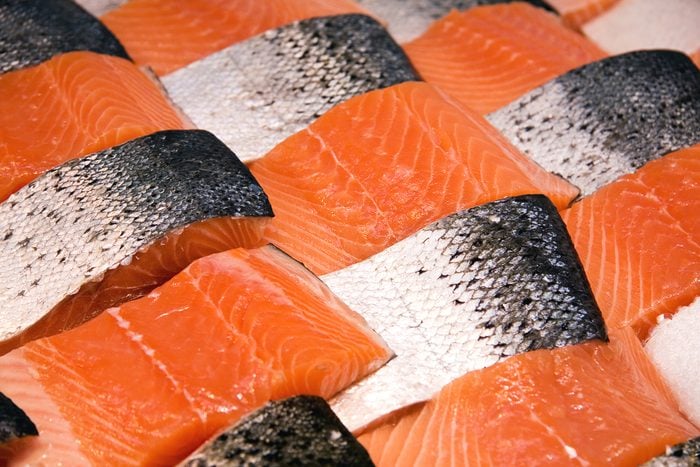Can You Eat Salmon Skin and Is It Good for You?

Can you eat salmon skin? The answer may surprise you…
Salmon is a popular high-protein food because of its host of health benefits. This tasty fish is rich in protein, omega-3 fatty acids and vitamins B and D. The Food and Drug Administration (FDA) recommend eating two to three servings of oily fish like salmon every week.
But have you ever wondered about the skin? Before you remove it, consider saving it for a recipe all its own.
Can You Eat Salmon Skin?
Yes, you can eat salmon skin. In fact, when cooked properly, salmon skin has a crispy, salty bite.
However, before chowing down, it’s important to take a few precautions. Depending on where your fish came from, it may contain environmental toxins. Salmon that live in contaminated water absorb toxins into their skin. This can make the skin unsafe to eat. In fact, a study in PLoS One found that a diet high in farmed salmon may raise the risk of obesity and type 2 diabetes.
If you’d like to try eating salmon skin, stick with wild-caught salmon. According to the Environmental Protection Agency (EPA), the most contaminated fish is farmed from the Atlantic Ocean. Wild-caught salmon from the Atlantic Ocean is slightly better. For the safest fish, look for salmon that was wild-caught in the Pacific Ocean.
Here are more tips on how to buy salmon.
Is Salmon Skin Good for You?
Salmon skin is rich in nutrients that have been linked to some serious health benefits. Salmon has a high level of omega-3 fatty acids. These good fats can lower the risk of heart disease and other chronic conditions.
Salmon skin is especially high in omega-3 fatty acids. Salmon live in cold ocean water, and their skin needs a high concentration of fat to keep them warm.
A study in Marine Drugs found that eating salmon skin may help to treat type 2 diabetes and improve wound healing. Eating a diet rich in omega-3 fatty acids may also help to prevent certain types of cancer.
How Do I Remove Salmon Skin?
Not ready to add salmon skin to your dinner rotation? No worries; it’s easy to remove from your fish before eating. To remove the skin from raw salmon, place your fillet on a cutting board with the skin side down. Press down on the fillet while placing the knife between the skin and the flesh. Then slide the knife carefully to remove the skin.
You may find that it’s easier to remove salmon skin from cooked fish. Start by grilling or baking salmon. Place your cooked fish on a clean cutting board and slide a sharp knife or spatula between the skin and flesh. Once you’ve removed the skin, season your fish and enjoy.
How to Cook Salmon Skin
Cooking salmon skin may sound tricky but it’s one of the easiest salmon recipes out there. There are just a few tips to keep in mind when making this crispy, salty snack.
If you’ve ever cooked salmon with the skin on, you know that the skin can quickly become soggy or rubbery. This is usually an issue when boiling or steaming the fish. Feel free to keep the skin on when you grill salmon because it will protect the flesh from burning.
One way to cook salmon skin is to make salmon bacon. Start by removing the skin from the fish and cutting it into one-inch strips. Then heat some cooking oil in a skillet over medium heat. Once the oil is hot, place your salmon skin strips in the skillet and turn them frequently to prevent burning. Once they’re crispy, remove the strips and place them on a paper towel-lined plate. Season with a little salt and pepper.
Serve your salmon bacon with a side dish for salmon and wow your guests.



